Working towards a sustainable environment
Vulnerability Assessment
Vulnerability Assessment and Mapping is used to ensure that waters both surface and ground waters, which may be susceptible to pollution from run-off are identified when preparing a land bank. If the site is of high vulnerability it may not be used for land spreading.
The GSI vulnerability maps indicate the vulnerability ratings within the majority of areas and where they are not available the area must be pionjared to identify the depth to bedrock.
The vulnerability mapping is based on the Vulnerability Classification Matrix, which assigns a vulnerability rating depending on the characteristics of the overburden deposits, the thickness of the strata and in case of drift aquifers, depth of the unsaturated zone. For example in areas where Karst features are present, the groundwater vulnerability is assumed to be extreme due to fast flow rates occurring in fissures and fractures only, limited attenuation capacity, and hence high probability of the contamination being propagated over extensive areas with unpredictable flow pathways. It should be noted that the vulnerability does not take account of contaminant source and loading rates.
OCAE carry out vulnerability assessments as part of their land bank study to ensure that a particular site is suitable for the receipt of organic fertiliser, we also carry out individual vulnerability assessments at client’s request.
